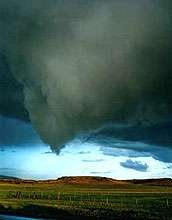Although tornadoes are usually thought of as springtime storms that develop in early evenings out of isolated weather cells, the twister that touched down in Indiana in the middle of the night this past weekend was a typical "line storm"-- one that is more likely to form late at night and in colder months.
Image: This funnel cloud developed in Clayton, N.M., well outside of "Tornado Alley." Credit: NOAA; Doug Berry and the Ball State University Storm Chasing Team
"In the heart of Tornado Alley, twisters most often develop from relatively small 'cell' storms that look like blotches on a Doppler radar weather map," said Purdue University scientist, Robert "Jeff" Trapp whose team studied more than 3,800 tornadoes between 1998 and 2000. "Over time, these cells frequently merge into line-shaped storms that can stretch hundreds of miles. The conventional wisdom has been that line storms don't often spawn tornadoes, but we found that a significant number did."
"The upshot of our analysis is that tornadoes form under a broader set of circumstances than meteorologists once thought, and this is especially true if you live far from Tornado Alley," said Trapp. "If you're driving in a midnight rain in October near Lake Michigan, remember that a tornado is not outside the realm of possibility."
Trapp's study, which he performed with colleagues at the University of Oklahoma, Colorado State University and the National Severe Storms Laboratory, is a step toward improving the ability to predict tornado strikes, which often come with only a few minutes' warning. The group initially set out to find which types of storms produce the destructive funnels.
Although 79 percent of the tornadoes they studied came from cells, Trapp said, 18 percent came from line storms nationwide. But in the Midwest, those numbers varied widely. In Ind., for example, about half of the tornadoes came from line storms.
"This implies that we may be overlooking many tornado-breeding storms in the Midwest and elsewhere," Trapp said. "Complicating the issue is that what we know about tornado formation is based largely on the cell-type storms observed in Okla. and Texas."
Cell storms often form in springtime in the late afternoon, which is why most storm warnings in Tornado Alley are issued in the evening, Trapp said. But line storms often form later at night and also in the cool season, between Oct. and March.
"These are the hours and months when people probably least expect severe weather," Trapp said. "In fact, they may not even see a tornado coming because of the lateness of the hour."
The silver lining to all these clouds is that tornadoes are less frequent overall in the Midwest — Ind. experiences only about 20 tornadoes a year, compared to about 52 in Okla. and 124 in Texas. And, Midwestern storms are often weaker than those of the plains. But because many of these tornadoes may go undetected, Trapp said, people outside Tornado Alley should begin to shift their thinking.
"We're not trying to be alarmist with these findings," he said. "But we hope that people will stay alert to tornado risk even outside the traditional severe storm season."
Trapp said that the current study represents a step toward better weather prediction, but there's still much work to be done.
"Now that we have a better picture of when and where tornadoes form, we can develop tools that can serve a practical purpose. For now, we are trying to raise awareness among weather watchers about tornado-forming situations that have been, figuratively speaking, beneath our radar."
This report appeared in the Feb. 2005 issue of the journal Weather and Forecasting, and was funded by the National Science Foundation.
Source: NSF
























